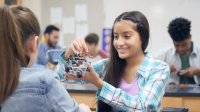Encouraging Students to Take Creative Risks With Technology
Middle school students can reprogram toys at maker events to develop a sense of the importance of persistence and problem-solving.
Your content has been saved!
Go to My Saved Content.Imagine giving a group of middle school students a toy train that rolls around a track at a consistent speed and asking them, “How can we make this toy even more interesting?” Students might imagine the ability to control the train so that it stops when it arrives at the train station, or to drive it both forward and backward. Students love to modify and redesign toys and games as part of creative exploration.
As an edtech developer, I believe in building children’s confidence in their own capabilities. One way I do this is through hardware hacking, which provides learners with existing technologies and encourages them to deconstruct, repurpose, improve, and re-create. You can do this at your school by hosting a hackathon, an event that provides students with the opportunity to engage in creative STEM challenges.
What Is Hacking?
A hackathon is an event in which students work in teams for a short amount of time to develop a working prototype of something. Although students are engaged in hands-on, experiential learning, the hackathon atmosphere differs from traditional project-based learning (PBL). While PBL assignments often progress over the course of a semester, hackathons are quite short—students have only hours, or maybe days, to complete a challenge.
This tight schedule motivates students to apply new skills immediately after they learn them. Hackathons teach students as they go, since the final aim is to create a functional hardware prototype that meets the demands of the challenge.
Hacking a Toy Train
At a recent hackathon competition, students from different schools in Hong Kong were given the challenge described above—redesigning a toy train. They were provided with wiring diagrams and code templates as supportive material.
I was one of their mentors; I worked with four students between the ages of 10 and 12, guiding them through the wiring and assembling of the components needed for their project. My team chose to equip their train with an Arduino board and control its movement by Bluetooth connection. For those who may not be familiar with a microcontroller or development board, Arduino is a credit card–size development board that is able to read inputs such as a light on a sensor, a finger on a button, or a Twitter message, and turn those inputs into an output: activating a motor, turning on an LED, or publishing something online.
The students I worked with first deconstructed the train to understand the working mechanisms inside it—they needed to understand the functions of various parts of the train in order to rewire it. We then connected the Arduino with a motor with additional wiring and other electrical components that would enable the train to move in different directions. This is a difficult step for students, since the rewiring does not always work on the first or second try.
Successfully completing this step accomplished two broader goals: getting students comfortable with failure and helping them learn how to debug, both of which are must-have skills for makers.
I tried to interrupt as little as possible. My role at hackathons is to advise and ensure the kids’ safety while they use tools like screwdrivers and soldering irons.
When the students were able to successfully channel power to the board, it was a rewarding moment for everyone. After they successfully hacked the hardware, they needed a new way to interact with the train’s electronics. I guided them to utilize Unity, a cross-platform game engine developed by Unity Technologies, to create a mobile application as an interface. Teachers can also utilize free resources developed by third parties, like nRF UART, to connect with the Arduino board.
Our team didn’t win the first prize in the competition, but all of the students had great fun throughout the day and received a lot of positive feedback from the judges. Hacking gave them a chance to fully understand the working mechanisms of science and technology behind any product. Equipping students with a maker mindset has a positive impact on learning experiences in STEM-related subjects.
Teachers without technical backgrounds can still help mentor students. Presentation skills are just as important as coding skills in hackathon competitions. Consider hosting an event like this at your school—the world needs more makers and creators.
